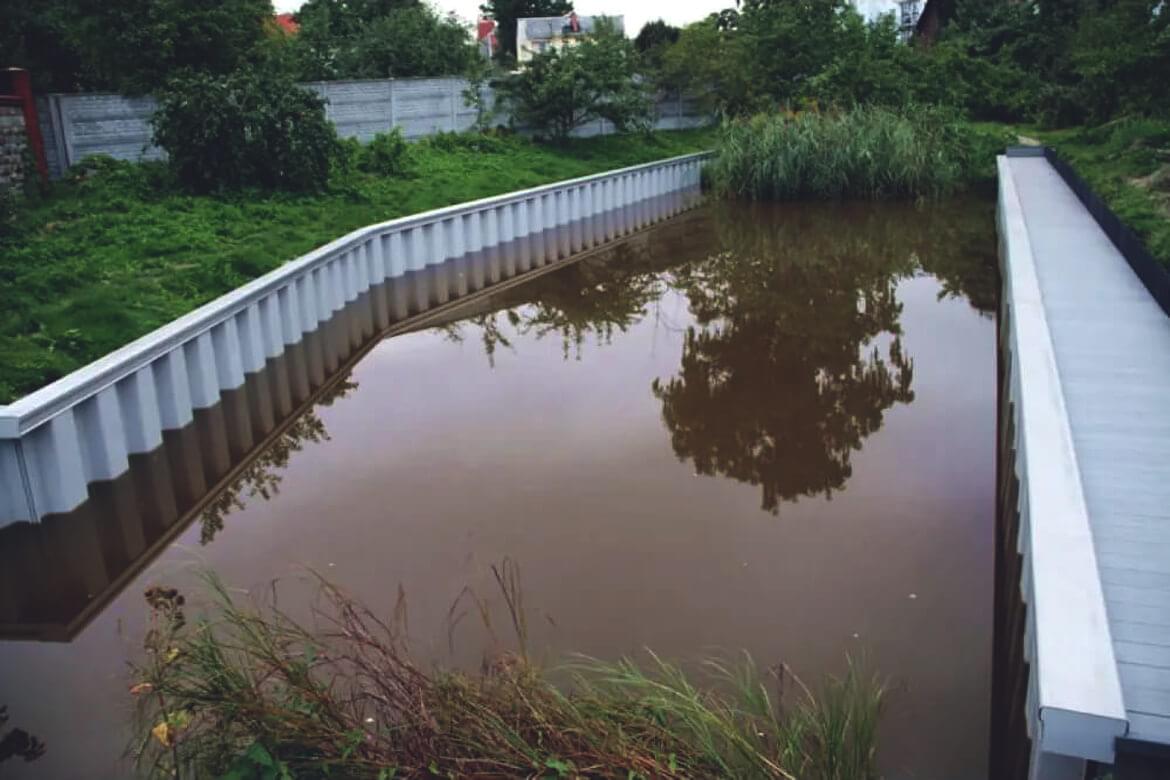Checking Out the Numerous Uses Bulkhead Frameworks in Modern Style
Bulkhead frameworks play a significant function in modern style, serving both practical and visual functions. They can define areas, improve storage remedies, and enhance lights. In business settings, they serve as prime focus that show brand identification - Bulkhead on Lake Livingston. In addition, their integration typically sustains sound administration and lasting methods. Understanding the complete extent of their applications discloses much concerning modern design fads and user experience. What innovative uses bulkheads might emerge in the future?
Defining Bulkhead Structures
Bulkhead frameworks play an important duty in modern design, functioning as necessary elements in different building layouts. These frameworks are generally specified as increased ceilings or systems, often used to conceal mechanical systems, wiring, or plumbing. Bulkheads can be discovered in both property and industrial setups, where they provide a seamless blend of performance and aesthetic appeals. Their design can incorporate lights fixtures and other decorative elements, improving the total visual allure of an area.
Typically built from materials such as drywall, metal, or wood, bulkheads can be tailored to fit the architectural style and demands of the structure (Bulkhead on Lake Livingston). They offer not just to conceal unattractive framework however likewise to produce specified areas within open rooms. By taking care of the flow of an area, bulkheads add to the spatial organization, making them a considerable facet of modern building method. Their interpretation encapsulates both visual and useful dimensions.
Practical Applications in Residential Design
Bulkhead frameworks play a crucial role in domestic style by assisting in space optimization techniques that maximize functional locations. They contribute aesthetic design aspects that improve the aesthetic allure of living rooms. On top of that, these structures supply essential structural assistance options, making sure the integrity and safety and security of the home.
Room Optimization Strategies
As modern-day domestic styles progressively focus on efficient use space, ingenious approaches emerge to make the most of performance without sacrificing aesthetic appeals. One famous strategy involves the assimilation of bulkhead frameworks, which can define areas while supplying necessary storage remedies. These structures can be used to create vertical storage devices that improve both company and accessibility. In addition, multi-functional furnishings, such as exchangeable sofas and foldable tables, enhances bulkhead layouts, allowing areas to adapt to varying needs. Open flooring plans additionally optimize spatial flow, encouraging versatility in usage. Incorporating integrated shelving and recessed lights within bulkheads likewise adds to a streamlined environment, ensuring that every square inch of room is used successfully and harmoniously within the general layout.
Aesthetic Design Elements

Structural Support Solutions
In modern household layout, an efficient architectural support option is necessary for preserving the integrity of areas while enhancing design and capability. Bulkhead structures play a significant function in this situation, working as both support and dividing components. They can hide mechanical systems, such as plumbing and electric wiring, while giving support to the ceiling and floor systems. By tactically positioning bulkheads, engineers can develop defined locations within open floor plans, improving use without endangering architectural security. Furthermore, these frameworks can suit lights fixtures, contributing to both visual appeals and practicality. To summarize, bulkhead frameworks are indispensable in domestic layout, providing versatile assistance remedies that improve both the capability and visual charm of living rooms.
Enhancing Looks in Industrial Rooms
When business areas embrace ingenious bulkhead structures, they not only specify physical boundaries but also greatly boost the overall aesthetic appeals of the atmosphere. These architectural components act as aesthetic prime focus, attracting focus and creating a sense of intrigue. By including varied products such as steel, glass, or wood, bulkheads can mirror a brand name's identification and goal, adding to a natural layout.
The critical positioning of bulkheads can control light and shadow, including depth and measurement to otherwise level spaces. This interaction can change a business area into an inviting environment, encouraging customer engagement. Furthermore, making use of shade and structure in bulkhead style can stimulate certain feelings, boosting the total consumer experience. Eventually, the thoughtful integration of bulkhead structures boosts the aesthetic appeal of industrial areas, making them not only practical yet likewise aesthetically captivating, thus fostering a long lasting impact on visitors.
Acoustic Efficiency and Sound Monitoring
Effective acoustic efficiency plays an important function in contemporary architecture, especially within business spaces where sound management is important. Bulkhead structures can significantly boost acoustic qualities by taking in sound, decreasing reverberation, and mitigating noise transfer between areas. These attributes are particularly advantageous in atmospheres such as theaters, restaurants, and offices, where clear interaction and a positive auditory experience are extremely important.
The strategic positioning and layout of bulkheads can aid produce sound-buffer areas, effectively separating loud areas from quieter ones. Products made use of in bulkhead building and construction, such as soft surfaces and acoustic panels, add to their sound-dampening abilities. Furthermore, the incorporation of bulkheads permits the combination of sound-absorbing components without compromising aesthetic appeal. By attending to acoustic performance, designers can develop unified settings that boost comfort, enhance individual experience, and promote performance, making bulkheads a vital part in the design of contemporary industrial spaces.
Incorporating Bulkheads for Efficient Room Use
Commonly forgotten, the assimilation of bulkheads in architectural design can considerably enhance area use in modern-day structures. These architectural aspects offer numerous practical purposes, using a method to conceal mechanical systems, electric wiring, and plumbing without endangering aesthetic appeals. By purposefully placing bulkheads, designers can develop specified areas within open click resources floor strategies, therefore assisting in better organization and circulation.
In addition, bulkheads can integrate storage space services and lights functions, taking full advantage of the capability of otherwise thrown away vertical space. In property setups, they might define zones such as cooking areas or living locations, while in business areas, they can enhance the efficiency of formats by plainly marking paths and workplace.
Eventually, the thoughtful integration of bulkheads contributes to a more organized and aesthetically appealing environment, permitting adaptable areas that can evolve with the demands of their residents. This technique not only enhances area however likewise fosters a more harmonious communication in between type and feature.
Bulkheads in Public Style

Building Visual Enhancements
While many architectural aspects go for performance, bulkheads in public design offer a twin function by enhancing visual allure. These frameworks frequently produce visual passion with their layout, incorporating perfectly with surrounding aspects. By using numerous products, structures, and colors, bulkheads can add to an one-of-a-kind identity for public rooms, such as airports, museums, and collections. Their tactical positioning assists to delineate areas, directing site visitors while including deepness to the total layout. Additionally, bulkheads can highlight illumination, developing vibrant ambiences that change throughout the day. This aesthetic improvement not just raises the visitor experience but also cultivates a sense of location, making bulkheads a crucial factor to consider in modern-day public style. Generally, bulkheads personify the fusion of form and function.

Structural Support Solutions
As architects look for cutting-edge means to improve the architectural stability of public spaces, bulkheads become important components in the layout and building and construction procedure. These structures supply vital support, particularly in locations based on hefty foot website traffic or dynamic loads. By dispersing weight equally, bulkheads help stop structural failure while enabling versatile layout options. In big venues, such as stadiums and convention centers, bulkheads are usually integrated into the total building structure, making certain security and safety. Additionally, they can promote the consolidation of energies and mechanical systems, adding to the efficiency of area Read Full Report usage. Eventually, bulkheads stand for an essential remedy in modern-day public architecture, strengthening both performance and protection in community-focused environments.
Environmental Management Steps
Integrating environmental protection measures right into public architecture has become increasingly important as urban developers focus on sustainability alongside architectural support. Bulkhead frameworks serve a twin purpose hereof, functioning as obstacles against erosion and flooding while all at once boosting the visual allure of city landscapes. Their design commonly includes natural environments such as greenery, which can improve air top quality and provide habitats for wild animals. Furthermore, bulkheads can be crafted with absorptive products that permit water absorption, reducing runoff and advertising groundwater recharge. This combination of environmental factors to consider not just maintains the environment yet also promotes community resilience versus climate adjustment. By using bulkheads efficiently, designers contribute to lasting urban advancement that straightens with modern environmental goals.
Future Patterns in Bulkhead Style
Arising trends in bulkhead layout mirror a growing emphasis on sustainability, development, and performance in contemporary architecture. Designers are progressively including environment-friendly materials, such as recycled composites and bioplastics, to decrease environmental impact. Additionally, the combination of clever technology is becoming common, allowing bulkheads to offer multi-functional functions, including power storage space and environment control.
In urban setups, modular bulkhead systems are acquiring grip, providing flexibility in layout and convenience of setup. These systems can be adapted to numerous landscapes, permitting effective area application. Furthermore, aesthetic factors to consider are progressing; bulkheads are currently being designed to enhance visual charm, frequently including creative components that resonate with neighborhood culture.
As environment durability ends up being a top priority, future bulkhead layouts will likely focus on flooding defense and stormwater management, ensuring structural stability while attending to environmental obstacles. This shift symbolizes an alternative method to architecture that meets both human needs and environmental obligations.
Often Asked Questions
What Materials Are Frequently Utilized for Bulkhead Building And Construction?
Typical materials for bulkhead building consist of concrete, steel, wood, and composite products. These options give longevity, structural stability, and resistance to ecological aspects, making them ideal for various applications in building and construction and engineering projects.
Exactly How Do Bulkheads Influence Building Energy Performance?
Bulkheads improve developing power efficiency by providing thermal insulation and lowering air leak (Bulkhead on Lake Livingston). They assist preserve interior temperatures, thus lowering home heating and cooling down demands, eventually leading to reduced power expenses and improved environmental sustainability
Are There Any Kind Of Building Ordinance Particular to Bulkhead Frameworks?
Yes, developing codes certain to bulkhead structures exist, differing by area. These laws commonly attend to safety, architectural integrity, and ease of access, guaranteeing that bulkheads satisfy needed standards for building and construction and layout within an offered jurisdiction.
Can Bulkheads Be Easily Modified or Removed Later?
Bulkheads can frequently be customized or removed, depending upon their design and construction. Nevertheless, such modifications might need cautious planning and adherence to building ordinance to assure architectural honesty and safety are maintained throughout the procedure.
What Are the Expenses Linked With Installing Bulkhead Structures?
The expenses connected with mounting bulkhead frameworks can differ considerably, commonly affected by products, design intricacy, and labor. Typically, expenditures vary from moderate to high, relying on the task's particular demands and area.
Bulkhead frameworks play an essential duty in modern-day architecture, offering as necessary parts in various structure styles. Bulkhead structures play an essential duty in residential design by promoting space optimization techniques that optimize functional locations. Commonly neglected, the view website assimilation of bulkheads in building style can significantly enhance room usage in contemporary buildings. As designers look for cutting-edge methods to enhance the structural honesty of public spaces, bulkheads arise as vital components in the style and building and construction process. The costs linked with installing bulkhead frameworks can vary substantially, typically influenced by materials, layout complexity, and labor.